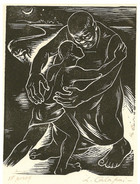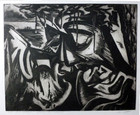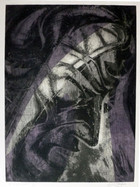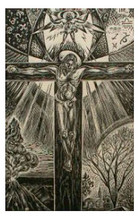Letterio Calapai
(1902-1993)
Letterio Calapai was destined for a life in the arts. The Boston-born son of Sicilian immigrants, he grew up in a home where his father read poetry, his mother played the piano, and he was taken from an early age to see the Great Masters at the city’s Museum of Fine Arts. Recognizing his artistic talent, a high school teacher gave him paints and brushes as a graduation present. As Calapai recalled: “It was the inspiration that led to the beginning of my career as an artist”—one that would span fifty years as art-maker and educator.
Studying at the Massachusetts Normal Art School (now the Massachusetts College of Art) and Boston’s School of Fine Arts and Crafts, Calapai proved to be especially gifted at figure painting and was preparing for a competition in Florence, Italy, when a freak accident in the summer of 1928 set him on a different course. His work for the jury was destroyed in a fire, and the artist decided to start over again in New York City. Calapai found work in a lithography shop, while continuing his studies at the Art Students League and the Beaux Arts Institute of Design.
Printer’s ink got into his blood. Calapai made his first wood engraving in 1934 and explored the medium in graphic artworks with social, religious, and literary themes like his much-admired series, inspired by Thomas Wolfe’s 1929 novel, Look Homeward Angel, combining elements of Social Realism and German Expressionism. Calapai offered this description of the printmaker’s craft: “The process involves the flights of his imagination, the power of his emotions, a striving for meaning and mystery, and the control over his tools.”
Calapai worked with African-American Author Lorenz Graham on a biblically-themed project in 1946. Lorenz had spent four years as a missionary-teacher in Liberia and re-wrote 21 stories from the Old and New Testament in the English dialect of West Africa for the anthology, How God Fixed Jonah. Calapai created 45 sparely beautiful, white-line prints as illustrations. Two of these wood engravings can be found in my collection, depicting the Story of Ruth (“Good in She Heart”) and the Parable of the Prodigal Son (“Hongry Catch the Foolish Boy.”)
During the 1940s, the printmaker embraced Modernism as assistant to British Abstract Expressionist Stanley William Hayter at the famed Atelier 17 graphic arts studio. Hayter was known for his experiments with “simultaneous color printing,” where inks of varying viscosities were added to an already colored intaglio plate to create a single multi-colored image. Calapai used the technique in a 1954 in an abstract series on The Seven Last Words of Christ. My collection includes “Woman Behold Thy Son! Behold Thy Mother!” (No. 3) and “It is Finished” (No. 6).
Calapai was a key figure in developing printmaking in America in the second half of the 20th century. He founded the Department of Graphics at the University of Buffalo and the Intaglio Workshop for Advanced Printmaking in New York’s Greenwich Village, influencing future generations of graphic artists as a teacher at New York University, the New School for Social Research in New York, Brandeis University, and the University of Illinois.
In the last years of his life, Calapai could be found making prints from nine to five every day of the week except Sundays in The Workshop Gallery, which he had set up in 1969 in a storefront studio in Glencoe, Illinois. Calapai’s later works marked a return to the realistic expressionism of his early prints, as can be seen in Spirit Triumphant, a 1981 wood engraving where the Crucifixion appears as a cataclysmic event with erupting volcanoes and sacred symbols cascading from the heavens.





